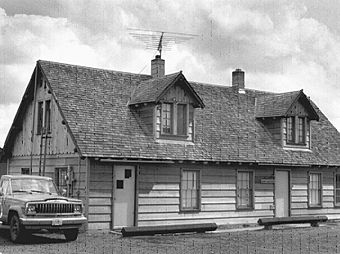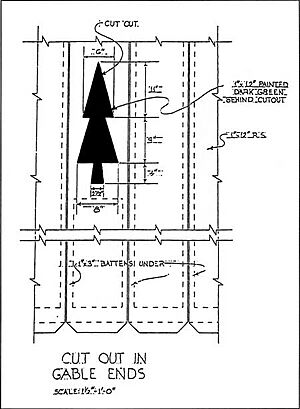Unity Ranger Station facts for kids
Quick facts for kids |
|
|
Unity Ranger Station
|
|

Unity Ranger Station bunkhouse, 1984
|
|
| Location | Wallowa-Whitman National Forest |
|---|---|
| Nearest city | Unity, Oregon, USA |
| Built | 1936–1938 |
| Architect | U.S. Forest Service, Pacific Northwest Regional Architecture Group |
| Architectural style | Cascadian rustic |
| NRHP reference No. | 86000823 |
| Added to NRHP | 1986 |
The Unity Ranger Station is a group of five buildings and a lookout tower. It is located in the Wallowa-Whitman National Forest in northeastern Oregon. This station used to be the main office for the Unity Ranger District. It is found in the small town of Unity, Oregon.
The old buildings were constructed in a natural, "rustic" style by the Civilian Conservation Corps (CCC) between 1936 and 1938. The CCC was a program during the Great Depression that put young men to work building things. Today, the ranger station is only used in the summer. It provides housing for Forest Service fire crews. The station is listed on the National Register of Historic Places, which means it's an important historical site.
Contents
History of the Ranger Station
In the early 1900s, it was hard to travel in the forests. Roads were not very good. To help people work in the National Forests, the Forest Service built ranger stations. These stations were placed in key spots to house full-time workers. They also provided support for firefighters and other crews working in faraway areas.
After World War II, the Forest Service built many more roads. This made it easier for workers to reach most forest areas quickly. Because of this, many isolated ranger stations were closed. Some were changed to summer-only stations, like Unity.
The Whitman National Forest was created in 1908. The Unity Ranger District was a part of this forest. It was in charge of about 194,000 acres (78,500 sq km) of forest land. This land was in the Blue Mountains of northeastern Oregon. In 1954, the Unity Ranger District became part of the much larger Wallowa-Whitman National Forest.
Building the Station
The Civilian Conservation Corps (CCC) started building at the Unity Ranger Station in 1936. Between 1936 and 1938, CCC crews built several buildings. Forest Service rangers watched over their work. All the buildings from that time were designed by the Forest Service's Pacific Northwest team. They were built in the "Cascadian rustic" style. This style uses natural materials and blends with the forest.
In 1953, two more buildings were moved to the station. They came from the John Day Experiment Station, a Forest Service research site. These buildings included a second house for a ranger and a bunkhouse (a building with beds for many people). The CCC had also built these buildings around the same time as the original station. They looked the same and were built with the same materials.
The Unity Ranger Station was a main office until 2002. Then, the Unity district joined two other districts, and the main office moved to Baker City, Oregon. However, a visitor center stayed open at Unity until 2009. Today, the Unity Ranger Station is only open during the summer. It is used to house Forest Service firefighters.
Why Unity Ranger Station is Special
There are six important old buildings at the Unity Ranger Station. They are all in great shape and are still used by Forest Service workers during the summer fire season. The Unity Ranger Station is very special because it's an early example of a Forest Service ranger station. Because of its history, it was added to the National Register of Historic Places on April 11, 1986. All the historic buildings are close together, so the historic area covers just 1 acre (4,000 m2).
Historic Buildings at Unity
The Unity Ranger Station has six historic buildings. They were all built by the Civilian Conservation Corps between 1936 and 1938. These buildings include two ranger houses, a bunkhouse, an equipment warehouse, a garage, and a fire lookout tower.
The buildings were made in the Cascadian rustic style. They have wood frames on concrete bases. The main building materials were wooden boards (clapboard), wood shingles, local lava stone, and concrete. Many of the triangular parts of the roof (gables) and the window shutters have a special "open pine tree" logo. This was a common design for Forest Service buildings from the 1930s.
- The first ranger residence (building #1051) was built by the CCC. It is a one-story, L-shaped building with a concrete base. It has a gabled roof. You can see decorative pine tree logos cut into the north and west gables. The outside walls are covered with wooden boards. The gables have vertical wood siding. There is a red lava stone chimney on the west side. The roof extends out to cover porches on the north and east sides. These porch roofs are held up by square wooden posts. The house has different types of windows, but they are all original. The outside of this building has not changed much.
- Near the first residence, there is a small rectangular residential garage. It is a one-story wooden building on a concrete base. It has a gabled roof covered with wood shingles. The garage has horizontal wood siding, with vertical wood at the gables. There is a large garage door on the west side and a regular door on the north. The outside siding of the garage was replaced in 1983, but with the same type of material.
- The Unity Ranger Station equipment warehouse is a wooden building also built by the CCC. It has a concrete base with a stone covering. It has a wood-shingled gabled roof with a large part sticking out, making the building L-shaped. There is a vehicle entrance under this sticking-out part. A red lava stone chimney is on the south side of the roof. The main roof extends out on the north side to cover a porch. Square wooden posts support the porch roof. The outside walls are horizontal wooden boards, with vertical wood siding at the gables. The windows are single-pane. There is a decorative pine tree logo cut out just below the peak of the projecting gable.
- A second residence (building #1052) was built by the CCC at the John Day Experiment Station. It was moved to the ranger station in 1953. This is an L-shaped, 1.5-story wooden building on a concrete base. It has a tall gabled roof with larger gabled windows (dormers) on the back (south side). There is a large gable on the northeast corner and a sloped roof over the front porch on the north side. Round, peeled-log posts hold up the porch roof. There is a brick chimney on the south side and a concrete chimney on the north side. The outside walls are horizontal wooden boards with wooden corner trim and vertical wood siding at the gables. This house has six-over-six double-hung windows. You can see decorative pine tree logos cut out just below the peak on the north, east, and west gables.
- Like residence #1052, the bunkhouse was first built at the John Day Experiment Station in the mid-1930s. It was moved to the ranger station in 1953. The bunkhouse is a 1.5-story, rectangular building. It has a wood frame, a concrete base, and a tall gabled roof with wooden shingles. It has two large gabled dormers on the front roof. There are also two cement chimneys on the roof ridge. The outside walls are horizontal wooden boards with vertical wood siding at the gables. The bunkhouse has six-over-six double-hung windows. There are decorative pine tree logos cut out just below the peak on the east and west gables and on the two dormers.
- The Unity Ranger Station has a combined fire lookout and water tower. This 60-foot (18 m) tall wooden tower was built by the Civilian Conservation Corps in 1938. The tower has a 7-foot (2.1 m) by 7-foot (2.1 m) room (cab) on top of a 12-foot (3.7 m) square deck. This deck has a catwalk with a simple wooden railing. The windows have wooden shutters that open from the top to shade the cab. The tower is built with special treated Douglas-fir wood. There is a wooden stairway leading up to the cab. A wooden water tank is located just below the cab. The tower has never been changed, so it looks just like it did when it was built.
Location of Unity Ranger Station
The Unity Ranger Station is in the small town of Unity, Oregon. Unity is in the southwestern part of Baker County, Oregon. It is surrounded by the Wallowa-Whitman National Forest. Today, the historic ranger station is part of the Whitman Ranger District. The area that used to be managed from Unity Ranger Station is the southern part of the Wallowa-Whitman National Forest. The station is about 4,038 feet (1,231 m) above sea level. The forest around the station has many large Ponderosa pine trees.
Unity is about 48 miles (77 km) southwest of Baker City on Oregon Route 245. John Day, Oregon, is about 49 miles (79 km) west of Unity on U.S. Highway 26. Vale, Oregon, is about 65 miles (105 km) southeast of Unity on U.S. 26. The old Unity Ranger Station is on the south side of Main Street (U.S. 26), near the center of Unity.
Images for kids








